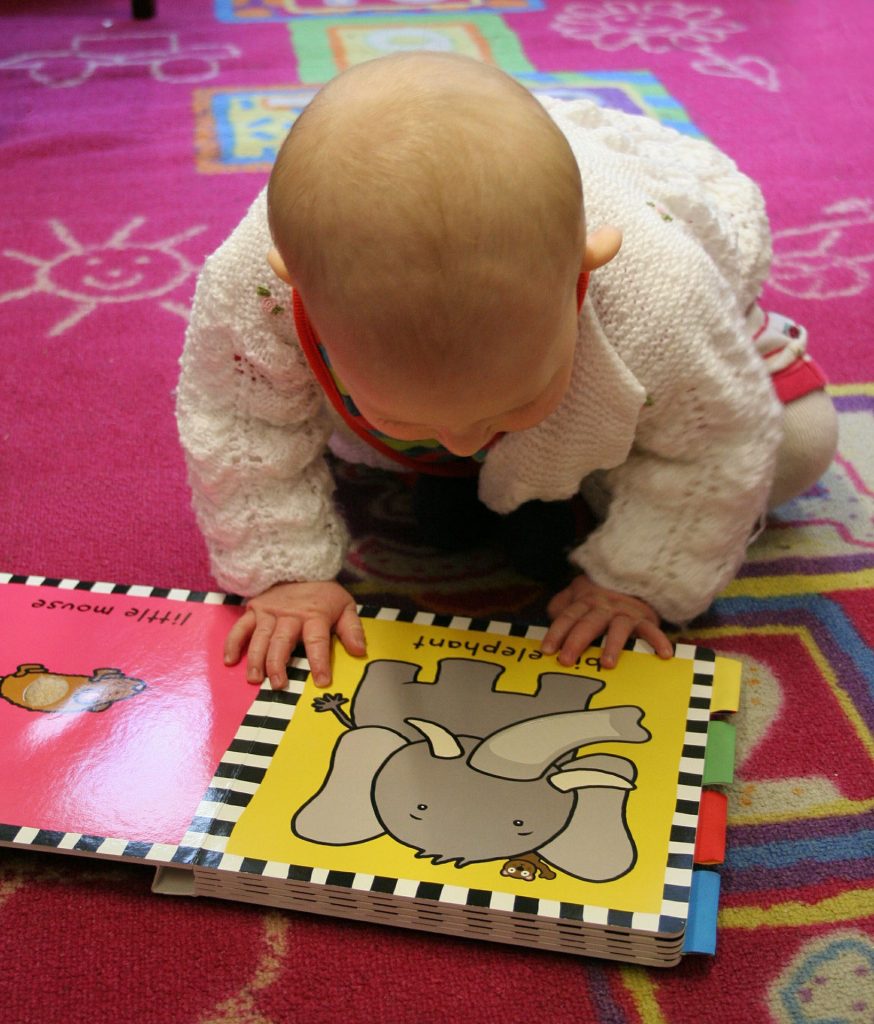Learning begins at birth! With every new sight, sound, smell, and personal interaction, her brain is making new connections that will last a lifetime. During her first few months of life, she will eat and sleep often. After this time, she will begin to move her head from side to side to see who’s in the room or what’s making that new noise. Shortly after this, she’ll discover that she can lift her head to see and hear better.
Curiosity is natural in all healthy babies, and curious babies are hungry for new experiences! Providing new experiences for your baby—based on her special needs—is an important part of her early learning.
The four parts of language are: speaking, listening, reading, and writing. All parts rely on one another. The ability to speak and listen comes before the ability to read and write. Even when your baby is not able to use words, she is a busy thinker!
Thoughts and ideas come before the ability to talk or write about them.
Talk to Me!
To help your baby grow into a child who can read and write, lay the groundwork by having “conversations” with your infant. Tell your baby about what you are doing. For example, during a diaper change, say, “Looks like it’s time for a diaper change! Let’s help you feel clean and fresh by changing your diaper. There’s my sweet guy! I need to lift your legs to move the diaper. There, does that feel better?”
During these conversations, be sure to pause at times when your baby would answer if he could. For example, you might say, “Who’s that in the mirror (pause)?” or “Did you have fun playing with your sister (pause)”? Pausing teaches your baby that conversations involve taking turns talking and listening. Eventually, your infant will babble when it’s his turn to talk.
These conversations also let your baby know that you care for him and enjoy being with him. When your baby starts babbling and cooing, speak with him as if you understand what he is saying. In his first year of life, you will see him trying to imitate your voice, the sounds you make, and your conversations with others.
Your baby will play with his own voice by making a wide range of sounds. His screams won’t always be about food or a soiled diaper—he might just be having fun making noise! Allow him to experiment, and encourage his enthusiasm.
Read to Me!
Studies have shown that reading to your child from infancy is the best way to encourage reading skills. To lay the groundwork for success with reading, read books and stories written for infants and small children once each day, right from the start!
Your local library will have many simple books with bright colors. Your librarian can help you choose books that are right for you and your baby. “Chunky” small books that your baby can chew on are also fun. (Make sure that your baby only chews on books that belong to you!) It’s okay to let your baby chew or suck on his first books—he’s learning that books are a fun part of life!
Reading is important to all of us. We read traffic signs, food labels, job applications, books, recipes, birthday cards, medical forms, instruction manuals, and more as a part of daily life. If you show your child that reading is fun and important to you, then it will be fun and important to your child.
Be sure to have a variety of different reading materials in the environment. Read lists, labels, and nice newspaper stories to the babies in your care. Reading aloud to your child allows him to hear new words, shows him that reading is a part of life, and shows him that reading is important to you.
Getting a Grip
Many common household objects can help your older infant develop motor skills that will help her learn to write. Large markers, mushy food on her plate, safe finger paints, and large safe crayons are all great tools. Swirling her fingers through her food might come before gripping a large pen, but both are important for developing her tiny hand muscles and her eye-hand coordination. These small hand muscles help her to hold a pencil and control its movement on paper.
Infant toys that allow her to grip, turn, squeeze, push, pull, and pinch are all good for the development of these muscles. When you take away small bits of lint or dirt from her carefully pinched thumb and forefinger to stop her from putting them in her mouth, be happy that she practicing her eye-hand coordination!


